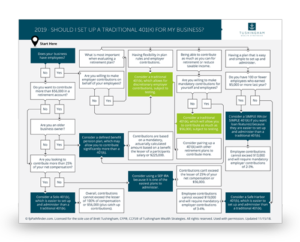December is almost here, and my children are already preparing their Christmas lists. These lists seem to get larger every year. Anyway, let’s get right to it and take a look at some planning strategies and pitfalls to avoid before year-end.
Maximizing Retirement Plan Contributions
Most families, and business owners, will be served well to maximize contributions to their respective retirement plans. Employee 401(k) limits are $18,500 for 2018 with $6,000 catch-up contributions available to those 50 or older by year-end. This limit increases to $19,000 for next year and the catch-up remains at $6,000.
Those who work for themselves (1099) or who have “side jobs” should also consider establishing their own retirement plans such as a Solo 401(k) or SEP IRA plan. Contribution limits for these plans could be substantially more than the employee limits on 401(k)’s so contact a professional to determine the best plan of action.

Bonus: Get our free flowchart “Should I Set Up a Traditional 401(k) For My Business?”.
Required Minimum Distributions (RMDs)
RMDs for 2018, must be taken by December 31, 2018, unless you have turned 70 ½ this year. In that case you have until April 1st of 2019. Be sure to not only take the required amounts but also make sure that the amounts have been distributed from the appropriate accounts. RMD’s from multiple IRA’s can be aggregated however RMD’s from employer retirement plans must be taken separately from each plan. The penalty for not taking the appropriate amounts is 50%.
Qualified Charitable Distributions
If you’re over 70 ½ you can make up to $100,000 in charitable contributions directly from your IRA. The check needs to be made payable directly to the charity. This can go towards meeting your annual RMD and is generally a more tax efficient way of giving to charity. The contribution will not increase your adjusted gross income, which many deductions and phase outs are tied to. You will also be able to deduct the contribution, even if you take the standard deduction.
Roth Conversion
If you happen to be in a lower tax bracket than usual you should consider a Roth conversion. This could be the case for many people transitioning to retirement who have not begun receiving Social Security or RMDs from their retirement accounts yet. It’s an opportunity to pay little or no tax on money that was contributed pre-tax at higher rates.
Proactive planning is required though as the conversion can not be reversed and will increase your adjusted gross income. Your adjusted gross income is utilized when calculating the taxability of Social Security benefits, college financial aid, Medicare surcharges, certain tax deductions and credits and your eligibility for health care exchange credits.
Flexible Spending Accounts
Health care FSA’s usually have a “use it or lose it” provision attached to them. Some plans will allow you to carry over $500 to the next year or provide a 2 ½ month grace period, however they are not required to do so. If you do have a remaining balance then consider using the funds on medically qualified expenses such as sunscreen, reading glasses and many over-the-counter medications.
Capture Losses…or Gains
Review your taxable accounts to capture losses that can be used to offset any gains and potentially reduce your taxable income by up to $3,000. Be careful not buy the same or similar security for 30 days to avoid what is called the “wash sale” rule.
Also, look for opportunities to harvest gains. You might be able to sell your winners and immediately buy back the same security with zero tax implications, increasing your tax basis in the process. You’ll need to do a tax analysis or work with a professional to determine the merits.
